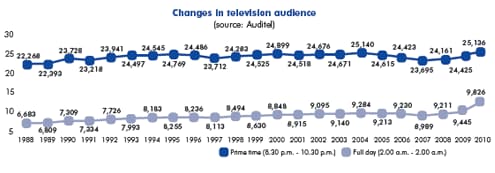2010 was a year destined to be
remembered as one of the most
important in the long history of Italian
television. This is demonstrated by four
particularly significant things:
• with the completion of the switch-off
of analogue terrestrial broadcasts all
over northern Italy, apart from Liguria,
almost 65% of Italians have now
switched permanently to digital
television;
• the comprehensive dissemination of
digital television platforms (digital
terrestrial, satellite and Iptv) has far
exceeded 80%;
• use of decoders/digital televisions
has now bypassed that of the
traditional analogue terrestrial
system;
• the television audience has reached
the highest level ever, thanks to the
expansion of the offering available to
the public and particularly that of free
digital terrestrial television, with over
9.8 million average daily viewers and
a daily viewing time per-capita of
more than four hours.
Despite the growing competition of
digital media, television shows evident
signs of vitality and strength which
enable it to confirm, once again, its
central role in the information and
entertainment system.
2010 was also positive in terms of
advertising revenues: according to the
estimates of Nielsen Media Research,
good growth (+6%) was recorded,
enabling television media to recover
about half the drop in advertising
investments recorded between 2008 and
2009 due to the economic crisis.
As mentioned, the switchover to DDT
was the main cause of discontinuity,
capable of generating the most
significant structural changes in the
competitive layout of the market.
According to the Auditel figures, the
dissemination of DDT exceeded 75% at
the end of 2010 (with an absolute value
of 18.7 million households) and in
December, fruition through this platform
reached almost 60%, making it the
system used most by Italian viewers to
watch television.
The offering available on the platform,
particularly in terms of free viewing, was
further strengthened thanks to the launch
of new specialized broadcasters. The
comprehensive share of digital terrestrial
channels doubled during 2010,
reaching about 15% of the whole day in
the month of December.
The offering of pay-tv was also
consolidated, gaining considerable
increases in terms of dissemination with
households, income from direct
customer spending and advertising
revenues, becoming even more
competitive with respect to Sky.
The satellite platform is substantially
stable. After about six months of a slight,
but progressive decline in the user base,
the pay operator, Sky, began growing
again, closing the year with over 4.8
million customers (about 200,000 of
which are business users), with a growth
of about 130,000 units (+3%)
compared with the end of 2009.

The inversion in trend recorded in the
second half of the year is due, among
other things, to the operator's aggressive
commercial policies to make the
bouquet more competitive in terms of
pricing and technological services (e.g.:
My Sky HD decoder).
As regards the free satellite offering, the
Tivý Sat platform managed as a joint
venture by Rai, Mediaset and Telecom
Italia Media and launched in 2009 with
the aim of guaranteeing full access to
the free offering by those people without
coverage by the digital terrestrial
broadcasting infrastructure, performed
very well.
Tivý Sat closed the year with almost
800,000 smart cards activated, showing
a clear increase compared to the end of
2009.
The IPTV platforms managed by the
telephone operators Fastweb, Telecom
Italia and Infostrada, continue to remain
stably widespread (estimated use by
about 600,000 households) at
substantially marginal values.
While migration to digital televisions
definitely represents the main factor of
short/medium-term discontinuity for the
television market, the long-term situation
will probably be characterized by the
development of landline and mobile
broadband structures and by the
growing offer of innovative content and
services accessible through convergent
devices capable of combining several
technologies and functions.
On this front too, 2010 was a very
important year for the definitive
consolidation of certain trends (e.g.:
online video consumption and the
success of so-called "catch up tv"
series) , the acceleration of state-of-theart
smartphone sales, the launch of
tablet pcs and the marketing of
television devices (e.g.: screens,
decoders, blue ray players) equipped
with Internet connections and therefore
able to allow users access to interactive
services and audio-visual content on
demand.
These phenomena are inevitably
destined to have even greater effects on
the market layouts, because they
encourage formidable boosts towards
the innovation of business and offering
models and are capable of opening up
the doors of business television to new
players, including those outside the
editorial sector.
In response to this, Rai has strengthened
its role, taking on the challenges posed
by digital TV and proposing:
• a new idea of Public Service, capable
of exploiting the multichannel
opportunities of the new technology
and placing itself at the service of the
public to an even greater extent;
• an offering without equal, such as to
simultaneously satisfy the specific
demands of the country's whole
creative and industrial system.












